Scenario Modeling of Urbanization Development and Water Scarcity Based on System Dynamics: A Case Study of Beijing–Tianjin–Hebei Urban Agglomeration, China
Abstract
1. Introduction
2. Materials and Methods
2.1. Study Area and Data Sources
2.2. General Framework and Concept Model
2.3. Dynamic Simulation Model Settings and Description
2.3.1. Water Supply Subsystem
2.3.2. Water Demand Subsystem
2.3.3. Water Pollution Subsystem
2.3.4. Population Urbanization Subsystem
2.3.5. Economic Urbanization Subsystem
2.3.6. Land Urbanization Subsystem
2.4. Parameters and Scenario Settings
2.4.1. Scenario Design of Water Supply
2.4.2. Scenario Design of Water Consumption Mode
2.4.3. Scenario Design of Urbanization Development
3. Results and Discussion
3.1. Validation Results of the SD Model
3.2. Water Supply under Different Scenarios
3.3. Urbanization Development under Different Scenarios
3.4. Water Scarcity under Different Scenarios
3.4.1. Scenarios of Water-Consuming Mode
3.4.2. Scenarios of Water-Saving Mode
4. Conclusions
Author Contributions
Funding
Conflicts of Interest
References
- Falkenmark, M.; Lundqvist, J.; Widstrand, C. Macro-scale water scarcity requires micro-scale approaches. Nat. Res. Forum 1989, 13, 258–267. [Google Scholar] [CrossRef]
- Dos Santos, S.; Adams, E.; Neville, G.; Wada, Y.; De Sherbinin, A.; Bernhardt, E.M.; Adamo, S. Urban growth and water access in sub-Saharan Africa: Progress, challenges, and emerging research directions. Sci. Total Environ. 2017, 607–608, 497–508. [Google Scholar] [CrossRef] [PubMed]
- Chitsaz, N.; Azarnivand, A. Water scarcity management in arid regions based on an extended multiple criteria technique. Water Resour. Manag. 2017, 31, 233–250. [Google Scholar] [CrossRef]
- Bao, C.; Fang, C. Water resources constraint force on urbanization in water deficient regions: A case study of the Hexi Corridor, arid area of NW China. Ecol. Econ. 2007, 62, 508–517. [Google Scholar] [CrossRef]
- Bao, C.; Zou, J. Exploring the coupling and decoupling relationships between urbanization quality and water resources constraint intensity: Spatiotemporal analysis for Northwest China. Sustainability 2017, 9, 1960. [Google Scholar] [CrossRef]
- Bao, C.; Zou, J. Analysis of spatiotemporal changes of the human-water relationship using water resources constraint intensity index in Northwest China. Ecol. Indic. 2018, 84, 119–129. [Google Scholar] [CrossRef]
- Vitale, K.; Afrić, I.; Pavić, T.; Holcer, N.J. Water shortage as a global public health challenge - overview of the situation in Croatia. Period. Biol. 2003, 105, 17–27. [Google Scholar]
- Azizullah, A.; Khattak, M.N.K.; Richter, P.; Häder, D. Water pollution in Pakistan and its impact on public health—A review. Environ. Int. 2011, 37, 479–497. [Google Scholar] [CrossRef]
- Luo, P.; Kang, S.; Apip; Zhou, M.; Lyu, J.; Aisyah, S.; Binaya, M.; Regmi, R.K.; Nover, D. Water quality trend assessment in Jakarta: A rapidly growing Asian megacity. PLoS ONE 2019, 14, e0219009. [Google Scholar] [CrossRef]
- Yang, W.; Song, J.; Higano, Y.; Tang, J. An integrated simulation model for dynamically exploring the optimal solution to mitigating water scarcity and pollution. Sustainability 2015, 7, 1774–1797. [Google Scholar] [CrossRef]
- Yang, W.; Song, J.; Higano, Y.; Tang, J. Combination of assessment indicators for policy support on water scarcity and pollution mitigation. Water 2016, 8, 203. [Google Scholar] [CrossRef]
- Azara, A.; Castiglia, P.; Piana, A.; Masia, M.D.; Palmieri, A.; Arru, B.; Maida, G.; Dettori, M. Derogation from drinking water quality standards in Italy according to the European Directive 98/83/EC and the Legislative Decree 31/2001—A look at the recent past. Ann Ig 2018, 30, 517–526. [Google Scholar] [PubMed]
- Fang, C. Important progress and future direction of studies on China’s urban agglomeration. J. Geogr. Sci. 2015, 25, 1003–1024. [Google Scholar] [CrossRef]
- Fang, C.; Yu, D. Urban agglomeration: An evolving concept of an emerging phenomenon. Landsc. Urban Plan. 2017, 162, 126–136. [Google Scholar] [CrossRef]
- Fang, C.; Bao, C.; Huang, J.C. Management implications to water resources constraint force on socio-economic system in rapid urbanization: A case study of Hexi Corridor, NW China. Water Resour. Manag. 2007, 21, 1613–1633. [Google Scholar] [CrossRef]
- Jiang, Y. China’s water scarcity. J. Environ. Manag. 2009, 11, 3185–3196. [Google Scholar] [CrossRef] [PubMed]
- Liu, M.; Wei, J.; Wang, G.; Wang, F. Water resources stress assessment and risk early warning–a case of Hebei Province China. Ecol. Indic. 2017, 73, 358–368. [Google Scholar] [CrossRef]
- Fitzhugh, T.W.; Richter, B.D. Quenching urban thirst: Growing cities and their impacts on freshwater ecosystems. Bioscience 2004, 54, 741–754. [Google Scholar] [CrossRef]
- Jenerette, G.D.; Larsen, L. A global perspective on changing sustainable urban water supplies. Glob. Planet. Chang. 2006, 50, 202–211. [Google Scholar] [CrossRef]
- Bao, C.; Fang, C. Water resources flows related to urbanization in China: Challenges and perspectives for water management and urban development. Water Resour. Manag. 2012, 2, 531–552. [Google Scholar] [CrossRef]
- Braud, I.; Breil, P.; Thollet, F.; Lagouy, M.; Branger, F.; Jacqueminet, C.; Kermadi, S.; Michel, K. Evidence of the impact of urbanization on the hydrological regime of a medium-sized periurban catchment in France. J. Hydrol. 2013, 485, 5–23. [Google Scholar] [CrossRef]
- Bao, C.; Fang, C. Study on the quantitative relationship between urbanization and water resources utilization in the Hexi Corridor. J. Nat. Resour. 2006, 21, 301–310. (In Chinese) [Google Scholar]
- Zhu, H.; Li, W.; Yu, J.; Sun, W.; Yao, X. An analysis of decoupling relationships of water uses and economic development in the two provinces of Yunnan and Guizhou during the first ten years of implementing the Great Western Development Strategy. Procedia Environ. Sci. 2013, 18, 864–870. [Google Scholar] [CrossRef]
- Bao, C.; Chen, X. The driving effects of urbanization on economic growth and water use change in China: A provincial-level analysis in 1997–2011. J. Geogr. Sci. 2015, 25, 530–544. [Google Scholar] [CrossRef]
- Bao, C.; Chen, X. Spatial econometric analysis on influencing factors of water consumption efficiency in urbanizing China. J. Geogr. Sci. 2017, 27, 1450–1462. [Google Scholar] [CrossRef]
- Bao, C.; Fang, C. Interaction mechanism and control modes on urbanization and water resources exploitation and utilization. Urban Stud. 2010, 17, 19–23. (In Chinese) [Google Scholar]
- Qin, H.-P.; Su, Q.; Khu, S.T. An integrated model for water management in a rapidly urbanizing catchment. Environ. Model. Softw. 2011, 26, 1502–1514. [Google Scholar] [CrossRef]
- Martin-Carrasco, F.; Garrote, L.; Iglesias, A.; Mediero, L. Diagnosing causes of water scarcity in complex water resources systems and identifying risk management actions. Water Resour. Manag. 2013, 27, 1693–1705. [Google Scholar] [CrossRef]
- Forrester, J.W. Industrial dynamics: A major breakthrough for decision makers. Harv. Bus. Rev. 1958, 36, 37–66. [Google Scholar]
- Forrester, J.W. Industrial Dynamics; Pegasus Communications: Waltham, MA, USA, 1961. [Google Scholar]
- Forrester, J.W. Urban Dynamics; MIT Press: Cambridge, MA, USA, 1969. [Google Scholar]
- Sterman, J.D. Business Dynamics: Systems Thinking and Modeling for a Complex World; Irwin McGraw-Hill: Boston, MA, USA, 2000. [Google Scholar]
- Gu, C.L.; Guan, W.H.; Liu, H.L. Chinese urbanization 2050: SD modeling and process simulation. Sci. China Earth Sci. 2017, 60, 1–16. [Google Scholar] [CrossRef]
- Sahin, O.; Stewart, R.A.; Porter, M.G. Water security through scarcity pricing and reverse osmosis: A system dynamics approach. J. Clean. Prod. 2016, 88, 160–171. [Google Scholar] [CrossRef]
- Nabavi, E.; Daniell, K.A.; Najafi, H. Boundary matters: The potential of system dynamics to support sustainability? J. Clean. Prod. 2017, 140, 312–323. [Google Scholar] [CrossRef]
- Du, L.; Li, X.; Zhao, H.; Ma, W.; Jiang, P. System dynamic modeling of urban carbon emissions based on the regional National Economy and Social Development Plan: A case study of Shanghai city. J. Clean. Prod. 2018, 172, 1501–1513. [Google Scholar] [CrossRef]
- Winz, I.; Brierley, G.; Trowsdale, S. The use of system dynamics simulation in water resources management. Water Resour. Manag. 2009, 23, 1301–1323. [Google Scholar] [CrossRef]
- Qi, C.; Chang, N.B. System dynamics modeling for municipal water demand estimation in an urban region under uncertain economic impacts. J. Environ. Manag. 2011, 92, 1628–1641. [Google Scholar] [CrossRef] [PubMed]
- Zarghami, M.; Akbariyeh, S. System dynamics modeling for complex urban water systems: Application to the city of Tabriz, Iran. Resour. Conserv. Recycl. 2012, 60, 99–106. [Google Scholar] [CrossRef]
- Sušnik, J.; Vamvakeridou-Lyroudia, L.S.; Savić, D.A.; Kapelan, Z. Integrated system dynamics modelling for water scarcity assessment: Case study of the Kairouan region. Sci. Total Environ. 2012, 440, 290–306. [Google Scholar] [CrossRef] [PubMed]
- Kotir, J.H.; Smith, C.; Brown, G.; Marshall, N.; Johnstone, R. A system dynamics simulation model for sustainable water resources management and agricultural development in the Volta River Basin, Ghana. Sci. Total Environ. 2016, 573, 444–457. [Google Scholar] [CrossRef] [PubMed]
- Wei, T.; Lou, I.; Yang, Z.; Li, Y. A system dynamics urban water management model for Macau, China. J. Environ. Sci. 2016, 50, 117–126. [Google Scholar] [CrossRef] [PubMed]
- Sun, Y.; Liu, N.; Shang, J.; Zhang, J. Sustainable utilization of water resources in China: A system dynamics model. J. Clean. Prod. 2017, 142, 613–625. [Google Scholar] [CrossRef]
- Li, T.; Yang, S.; Tan, M. Simulation and optimization of water supply and demand balance in Shenzhen: A system dynamics approach. J. Clean. Prod. 2019, 207, 882–893. [Google Scholar] [CrossRef]
- Bao, C.; He, D. Spatiotemporal characteristics of water resources exploitation and policy implications in the Beijing-Tianjin-Hebei Urban Agglomeration. Prog. Geog. 2017, 36, 58–67. (In Chinese) [Google Scholar]
- Chen, Z.; Jiang, W.; Wang, W.; Deng, Y.; He, B.; Jia, K. The impact of precipitation deficit and urbanization on variations in water storage in the Beijing-Tianjin-Hebei Urban Agglomeration. Remote Sens. 2018, 10, 4. [Google Scholar] [CrossRef]
- Lu, D.D. Function orientation and coordinating development of subregions within the Jing-Jin-Ji Urban Agglomeration. Prog. Geogr. 2015, 34, 265–270. (In Chinese) [Google Scholar]
- Li, J.; Zheng, X.; Zhang, C.; Chen, Y. Impact of land-use and land-cover change on meteorology in the Beijing–Tianjin–Hebei Region from 1990 to 2010. Sustainability 2018, 10, 176. [Google Scholar] [CrossRef]
- Tian, L.; Xu, G.; Fan, C.; Zhang, Y.; Gu, C.; Zhang, Y. Analyzing mega city-regions through integrating urbanization and eco-environment systems: A case study of the Beijing-Tianjin-Hebei Region. Int. J. Environ. Res. Public Health 2019, 16, 114. [Google Scholar] [CrossRef]
- Gu, C.L.; Xin, Z.P. Water resources development modes of foreign urban agglomerations and implications for China. Urban Probl. 2014, 10, 36–42. (In Chinese) [Google Scholar]
- Cheng, X.; Chen, L.; Sun, R.; Jing, Y. Identification of regional water resource stress based on water quantity and quality: A case study in a rapid urbanization region of China. J. Clean. Prod. 2019, 209, 216–223. [Google Scholar] [CrossRef]

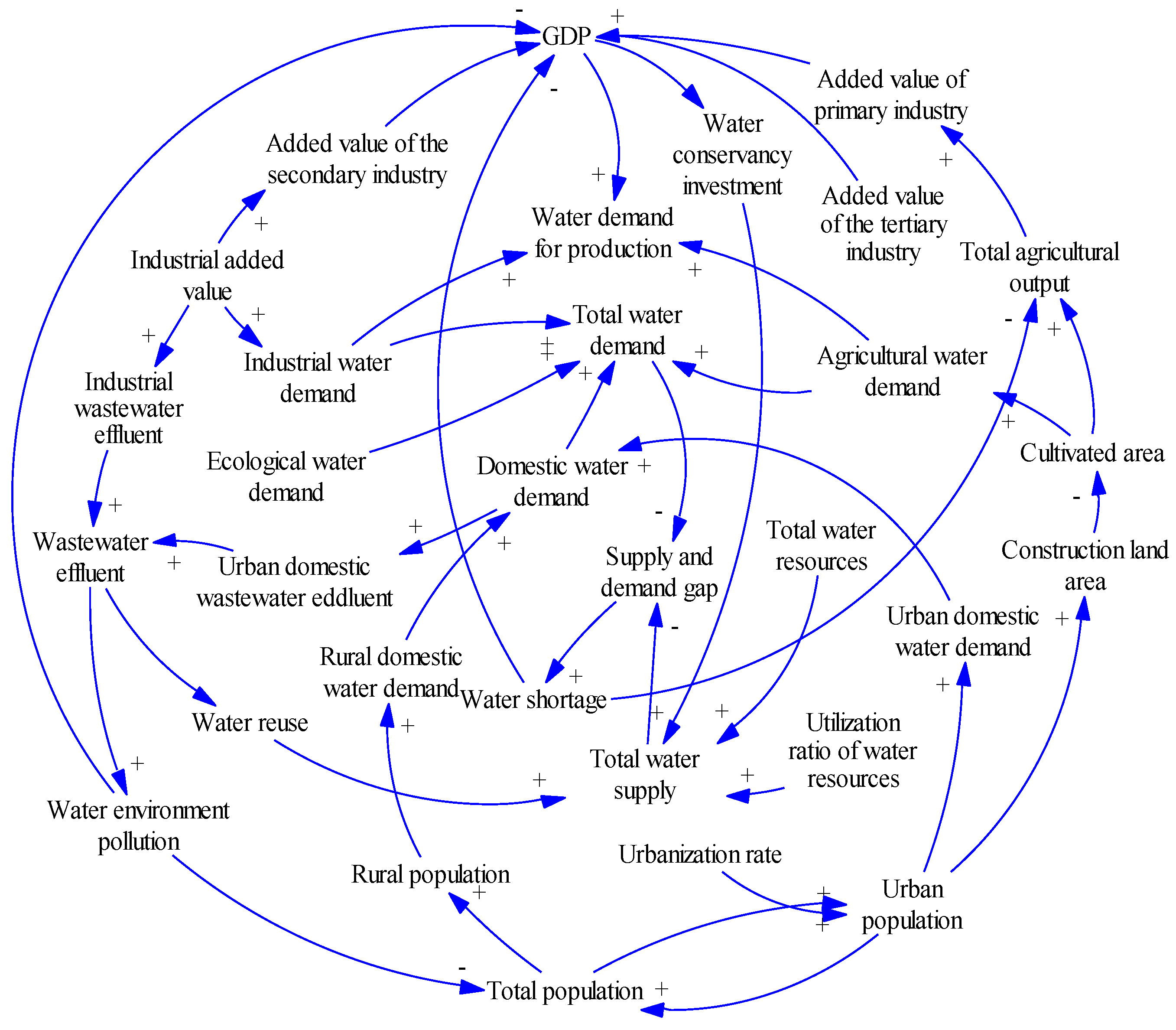
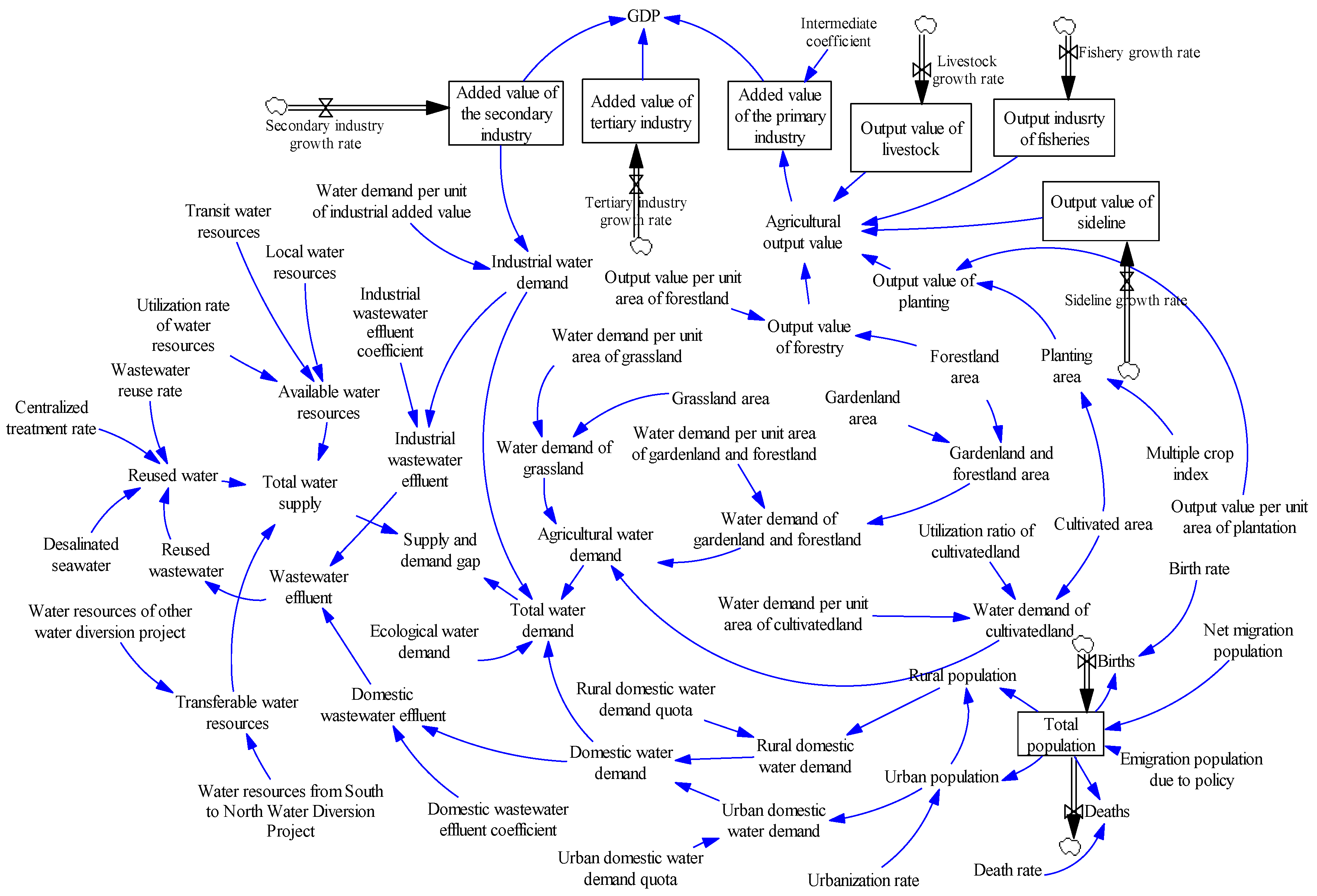
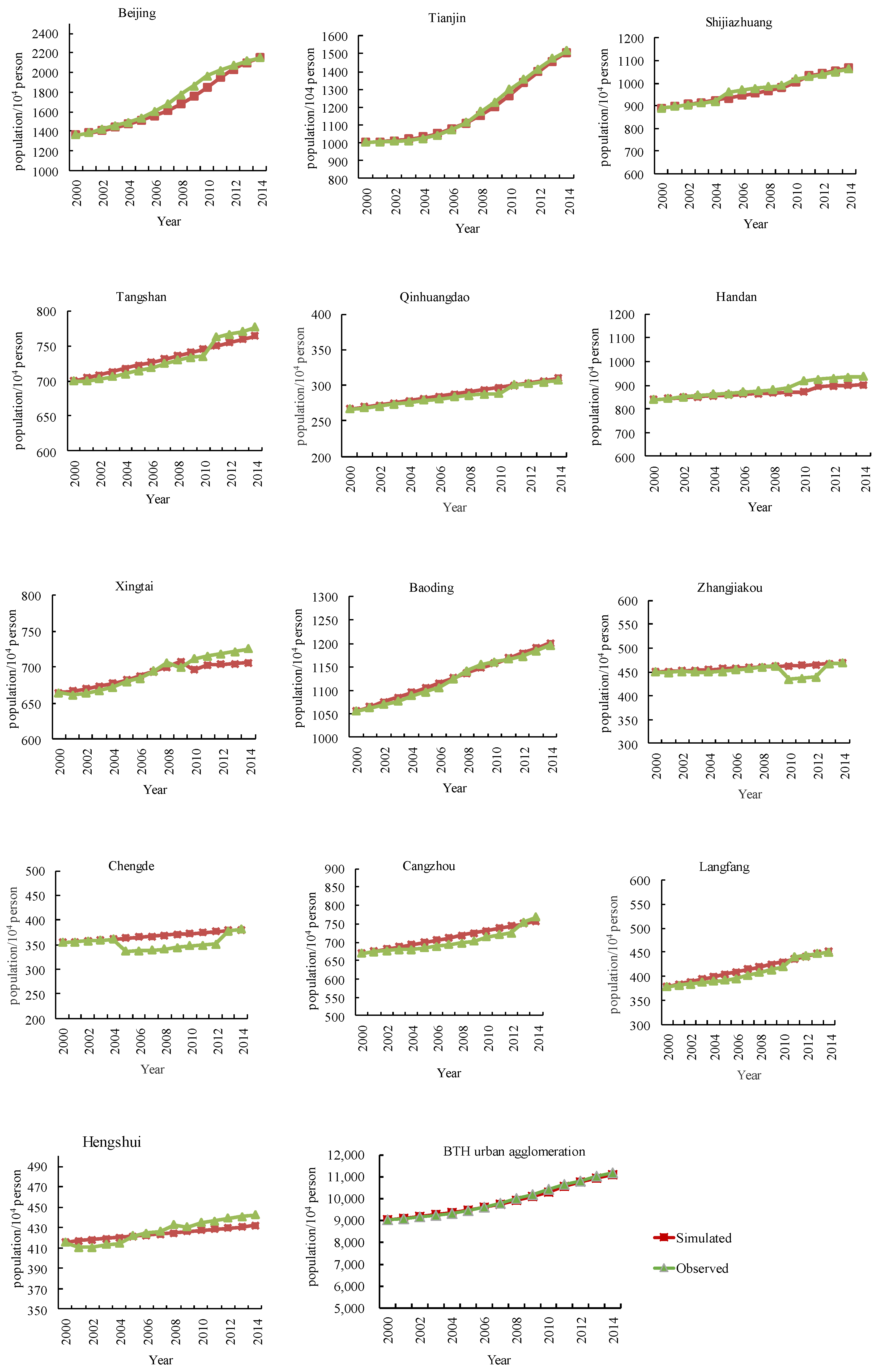
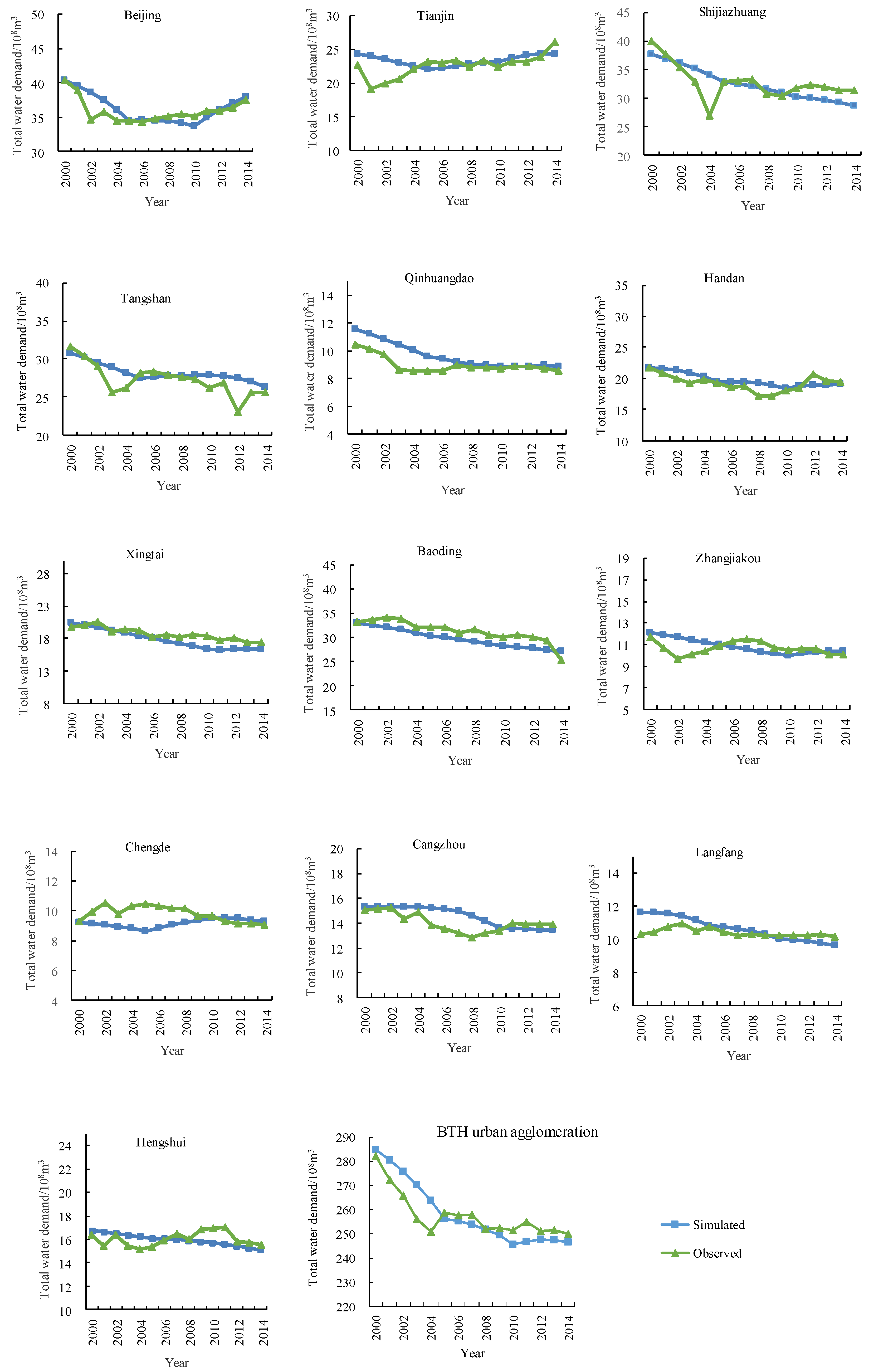
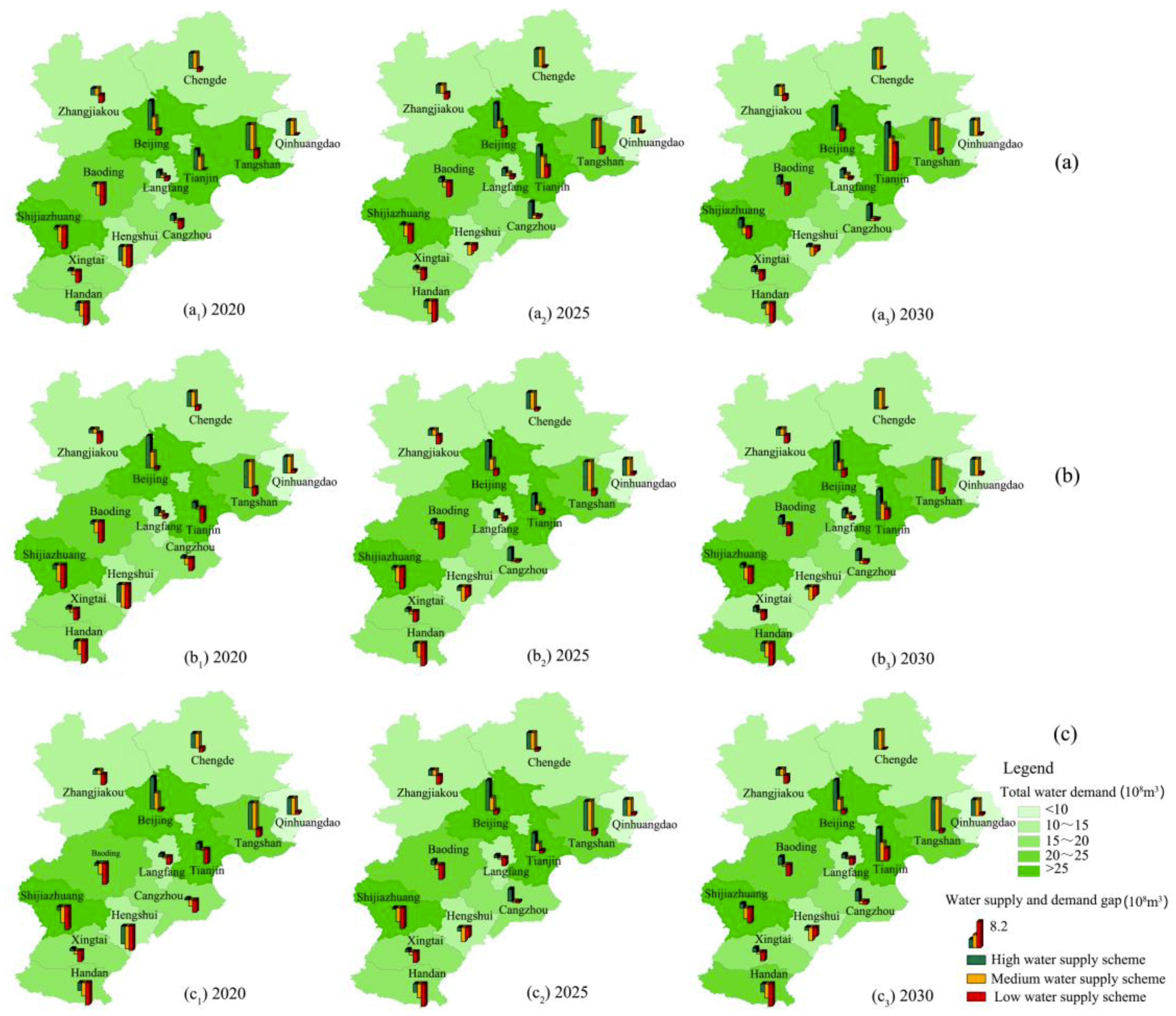
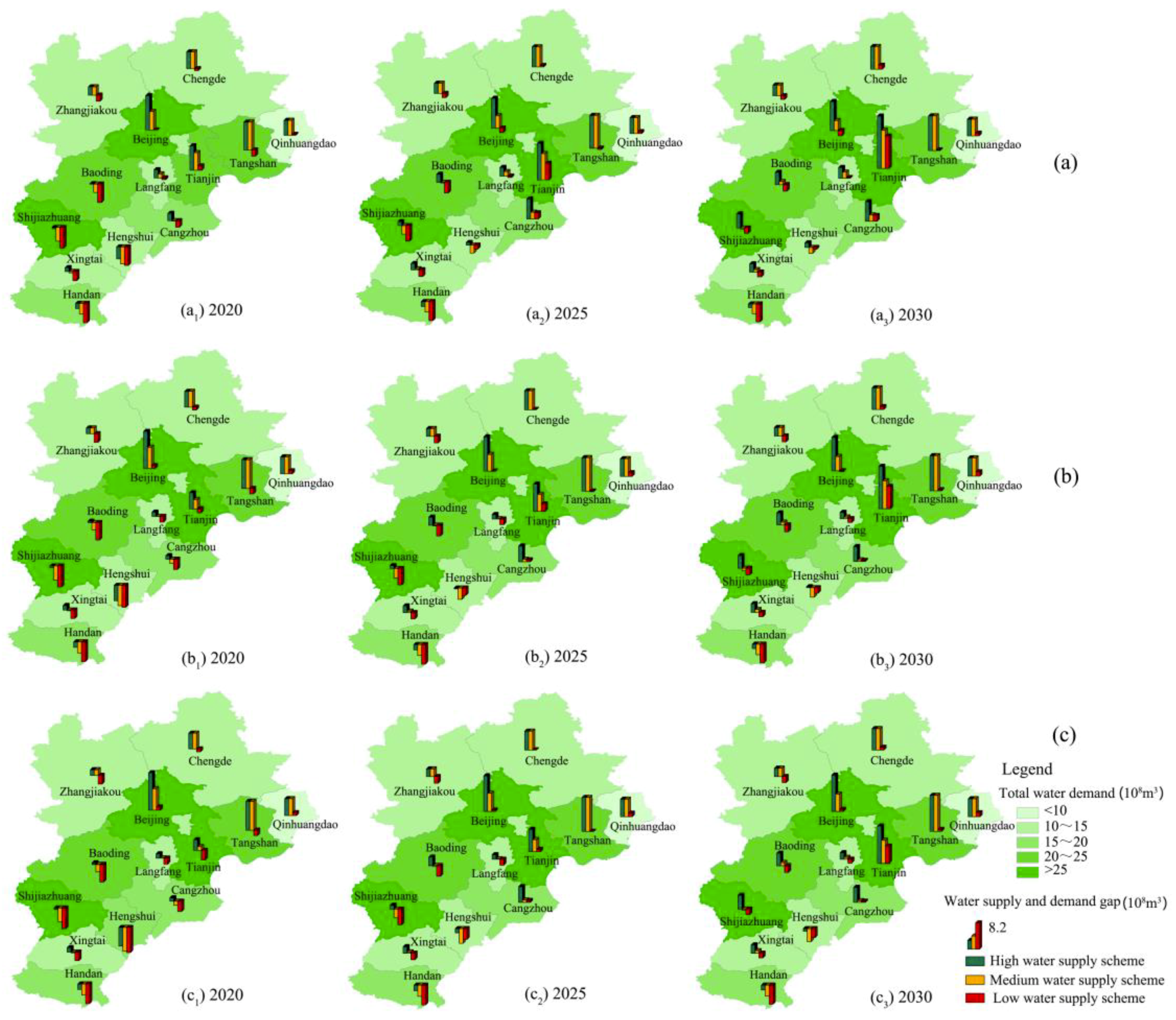
| Cities | High Water Supply Scheme | Medium Water Supply Scheme | Low-Water Supply Scheme | |||||||||
|---|---|---|---|---|---|---|---|---|---|---|---|---|
| 2015 | 2020 | 2025 | 2030 | 2015 | 2020 | 2025 | 2030 | 2015 | 2020 | 2025 | 2030 | |
| Beijing | 43.8 | 50.8 | 52.8 | 55.1 | 41.8 | 45.8 | 47.3 | 49.1 | 33.1 | 40.0 | 42.0 | 44.3 |
| Tianjin | 21.4 | 31.5 | 38.0 | 45.4 | 21.4 | 29.3 | 34.7 | 40.9 | 15.1 | 25.2 | 31.7 | 39.1 |
| Shijiazhuang | 26.8 | 27.1 | 27.6 | 29.8 | 22.9 | 23.2 | 23.7 | 25.1 | 20.7 | 21.1 | 21.5 | 23.7 |
| Tangshan | 32.7 | 33.0 | 33.3 | 33.6 | 32.7 | 33.0 | 33.3 | 33.6 | 22.0 | 22.3 | 22.6 | 22.9 |
| Qinhuangdao | 13.2 | 13.3 | 13.3 | 13.4 | 13.2 | 13.3 | 13.3 | 13.4 | 8.8 | 8.9 | 8.9 | 9.0 |
| Handan | 17.1 | 17.2 | 17.2 | 17.7 | 15.3 | 15.4 | 15.5 | 15.7 | 12.6 | 12.7 | 12.8 | 13.2 |
| Xingtai | 15.6 | 15.7 | 15.9 | 16.3 | 14.0 | 14.1 | 14.2 | 14.5 | 11.6 | 11.7 | 11.8 | 12.3 |
| Baoding | 23.6 | 23.8 | 24.2 | 24.9 | 20.9 | 21.1 | 21.4 | 22.0 | 17.7 | 17.9 | 18.3 | 19.0 |
| Zhangjiakou | 13.7 | 13.8 | 13.9 | 13.9 | 13.7 | 13.8 | 13.9 | 13.9 | 9.17 | 9.3 | 9.4 | 9.4 |
| Chengde | 17.7 | 17.8 | 17.8 | 17.9 | 17.7 | 17.8 | 17.8 | 17.9 | 11.9 | 11.9 | 12.0 | 12.0 |
| Cangzhou | 18.3 | 18.6 | 22.4 | 22.9 | 15.9 | 16.2 | 18.3 | 18.7 | 14.0 | 14.2 | 18.1 | 18.5 |
| Langfang | 12.6 | 12.8 | 13.1 | 13.7 | 11.3 | 11.5 | 11.8 | 12.2 | 9.5 | 9.7 | 9.9 | 10.5 |
| Hengshui | 9.3 | 9.3 | 12.9 | 13.1 | 7.7 | 7.8 | 9.6 | 9.8 | 7.2 | 7.3 | 10.9 | 11.0 |
| BTH | 265.8 | 284.6 | 302.4 | 317.7 | 248.6 | 262.1 | 274.8 | 286.8 | 193.3 | 212.0 | 229.8 | 245.0 |
| Cities | Time | Core Development Mode | Subcore Development Mode | Multinode Development Mode | ||||||
|---|---|---|---|---|---|---|---|---|---|---|
| TP (million) | UR (%) | GDP (billion yuan) | TP (million) | UR (%) | GDP (billion yuan) | TP (million) | UR (%) | GDP (billion yuan) | ||
| Beijing | 2020 | 23.6 | 89.5 | 1985 | 23.1 | 88.5 | 1988 | 23.1 | 87.5 | 1982 |
| 2025 | 25.4 | 92.5 | 2868 | 24.6 | 90.5 | 2852 | 24.2 | 89.5 | 2824 | |
| 2030 | 27.2 | 94.5 | 4089 | 26.5 | 92.5 | 4022 | 25.5 | 90.5 | 3941 | |
| Tianjin | 2020 | 17.7 | 84.6 | 1919 | 18.0 | 85.6 | 1945 | 17.8 | 83.6 | 1909 |
| 2025 | 19.9 | 86.6 | 2803 | 20.2 | 87.1 | 2938 | 20.2 | 84.1 | 2743 | |
| 2030 | 22.1 | 87.6 | 4120 | 22.4 | 89.1 | 4458 | 22.6 | 85.1 | 3929 | |
| Shijiazhuang | 2020 | 11.5 | 61.3 | 701 | 11.7 | 63.3 | 708 | 11.6 | 62.3 | 702 |
| 2025 | 12.2 | 66.3 | 976 | 12.6 | 69.3 | 1004 | 12.5 | 67.3 | 975 | |
| 2030 | 13.0 | 74.3 | 1345 | 13.4 | 74.3 | 1410 | 13.5 | 72.3 | 1346 | |
| Tangshan | 2020 | 7.9 | 60.3 | 637 | 7.9 | 62.3 | 640 | 8.0 | 61.3 | 633 |
| 2025 | 8.2 | 62.3 | 850 | 8.2 | 64.3 | 867 | 8.3 | 63.3 | 830 | |
| 2030 | 8.4 | 64.3 | 1132 | 8.4 | 66.3 | 1173 | 8.7 | 65.3 | 1087 | |
| Qinhuangdao | 2020 | 3.3 | 61.1 | 188 | 3.3 | 62.1 | 189 | 3.3 | 63.1 | 190 |
| 2025 | 3.5 | 66.1 | 253 | 3.5 | 67.1 | 258 | 3.5 | 68.1 | 262 | |
| 2030 | 3.6 | 70.1 | 334 | 3.6 | 71.1 | 346 | 3.7 | 72.1 | 356 | |
| Handan | 2020 | 9.2 | 54.0 | 419 | 9.2 | 55.0 | 422 | 9.2 | 56.0 | 424 |
| 2025 | 9.3 | 58.0 | 565 | 9.3 | 60.0 | 580 | 9.4 | 62.0 | 586 | |
| 2030 | 9.5 | 62.0 | 750 | 9.5 | 64.0 | 787 | 9.6 | 66.0 | 800 | |
| Xingtai | 2020 | 7.1 | 54.0 | 227 | 7.1 | 52.0 | 233 | 7.1 | 53.0 | 233 |
| 2025 | 7.2 | 58.0 | 296 | 7.2 | 57.0 | 306 | 7.2 | 58.0 | 310 | |
| 2030 | 7.2 | 62.0 | 381 | 7.2 | 62.0 | 398 | 7.3 | 63.0 | 408 | |
| Baoding | 2020 | 12.7 | 56.7 | 510 | 12.7 | 60.7 | 515 | 12.7 | 58.7 | 518 |
| 2025 | 13.3 | 60.7 | 717 | 13.3 | 64.7 | 742 | 13.4 | 62.7 | 735 | |
| 2030 | 13.9 | 64.7 | 996 | 13.9 | 66.7 | 1060 | 14.1 | 65.7 | 1035 | |
| Zhangjiakou | 2020 | 4.8 | 56.2 | 163 | 4.8 | 58.2 | 163 | 4.8 | 57.2 | 174 |
| 2025 | 4.8 | 60.2 | 227 | 4.8 | 62.2 | 228 | 4.9 | 61.2 | 244 | |
| 2030 | 4.90 | 62.2 | 318 | 4.9 | 64.2 | 322 | 5.0 | 63.2 | 339 | |
| Chengde | 2020 | 3.9 | 53.0 | 134 | 3.9 | 55.0 | 135 | 4.0 | 57.0 | 143 |
| 2025 | 4.0 | 58.0 | 192 | 4.0 | 60.0 | 195 | 4.1 | 61.0 | 208 | |
| 2030 | 4.1 | 61.0 | 272 | 4.1 | 62.0 | 282 | 4.3 | 63.0 | 302 | |
| Cangzhou | 2020 | 8.0 | 54.2 | 373 | 8.0 | 56.2 | 376 | 8.0 | 55.2 | 382 |
| 2025 | 8.3 | 59.2 | 529 | 8.3 | 61.2 | 546 | 8.5 | 60.2 | 547 | |
| 2030 | 8.7 | 63.2 | 738 | 8.7 | 65.2 | 781 | 9.0 | 64.2 | 772 | |
| Langfang | 2020 | 4.9 | 60.0 | 271 | 4.9 | 62.0 | 273 | 4.9 | 61.0 | 275 |
| 2025 | 5.1 | 65.0 | 392 | 5.2 | 67.0 | 403 | 5.3 | 66.0 | 395 | |
| 2030 | 5.4 | 68.0 | 567 | 5.7 | 70.0 | 593 | 5.7 | 69.0 | 564 | |
| Hengshui | 2020 | 4.4 | 54.3 | 179 | 4.4 | 56.3 | 183 | 4.4 | 58.3 | 187 |
| 2025 | 4.5 | 58.3 | 245 | 4.5 | 60.3 | 256 | 4.5 | 62.3 | 265 | |
| 2030 | 4.5 | 60.3 | 330 | 4.5 | 62.3 | 356 | 4.6 | 64.3 | 375 | |
| BTH | 2020 | 118.9 | 67.5 | 7707 | 118.9 | 68.6 | 7769 | 118.9 | 67.8 | 7752 |
| 2025 | 125.7 | 71.6 | 10913 | 125.8 | 72.5 | 11176 | 126.0 | 71.5 | 10924 | |
| 2030 | 132.6 | 75.0 | 15371 | 132.8 | 75.7 | 15986 | 133.6 | 74.2 | 15255 | |
© 2019 by the authors. Licensee MDPI, Basel, Switzerland. This article is an open access article distributed under the terms and conditions of the Creative Commons Attribution (CC BY) license (http://creativecommons.org/licenses/by/4.0/).
Share and Cite
Bao, C.; He, D. Scenario Modeling of Urbanization Development and Water Scarcity Based on System Dynamics: A Case Study of Beijing–Tianjin–Hebei Urban Agglomeration, China. Int. J. Environ. Res. Public Health 2019, 16, 3834. https://doi.org/10.3390/ijerph16203834
Bao C, He D. Scenario Modeling of Urbanization Development and Water Scarcity Based on System Dynamics: A Case Study of Beijing–Tianjin–Hebei Urban Agglomeration, China. International Journal of Environmental Research and Public Health. 2019; 16(20):3834. https://doi.org/10.3390/ijerph16203834
Chicago/Turabian StyleBao, Chao, and Dongmei He. 2019. "Scenario Modeling of Urbanization Development and Water Scarcity Based on System Dynamics: A Case Study of Beijing–Tianjin–Hebei Urban Agglomeration, China" International Journal of Environmental Research and Public Health 16, no. 20: 3834. https://doi.org/10.3390/ijerph16203834
APA StyleBao, C., & He, D. (2019). Scenario Modeling of Urbanization Development and Water Scarcity Based on System Dynamics: A Case Study of Beijing–Tianjin–Hebei Urban Agglomeration, China. International Journal of Environmental Research and Public Health, 16(20), 3834. https://doi.org/10.3390/ijerph16203834





